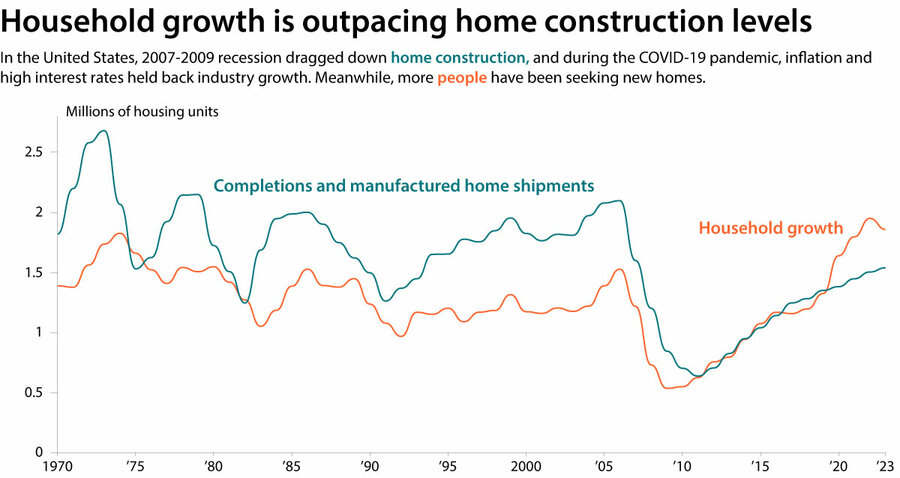In the USA, 1 in 4 renters spends over half their earnings on hire, and thousands and thousands of potential homebuyers can’t discover a house inside their worth vary, in keeping with Harvard College’s Joint Middle for Housing Research. Put merely, there are much more individuals looking for housing than there are locations to purchase or hire, pushing costs past what many can afford.
It’s putting how common the problem has turn out to be for renters, says Alexander Hermann, senior analysis affiliate on the middle. Zillow estimates that 4.5 million fewer houses can be found than the variety of People prone to be trying to both hire or purchase.
Rents are “rising for households of each race and ethnicity,” he says. “They’re rising for households who’re employed. They’re rising for households at all ages. It’s not simply anybody group that’s experiencing higher affordability challenges. It’s principally everybody on the renters’ facet.”
Why We Wrote This
Extra individuals are searching for houses than there are locations to purchase or hire, which contributes to excessive costs. Right here’s what led to the housing disaster, and a few potential options.
Right here’s a take a look at how we obtained right here.
What’s inexpensive housing?
“Inexpensive housing” is a technical time period utilized by policymakers and statisticians, in addition to a harder-to-define social phenomenon. They each replicate the concept individuals mustn’t spend greater than a sure proportion of their earnings on hire or mortgage.
The federal authorities defines inexpensive housing as costing the renter 30% or much less of their earnings. It makes use of a measure referred to as Space Median Revenue – the midpoint of the distribution of family incomes of a sure place. It’s utilized by entities from native businesses to the U.S. Division of Housing and City Improvement. For instance, HUD gives Part 8 vouchers – which assist individuals afford housing within the personal market – for individuals who make 80%, 50%, and 30% of the median earnings determine the place they reside.
The provision scarcity is worst in massive cities, significantly on the coasts. However lately, proudly owning a house, and even discovering an excellent rental, has begun to really feel out of attain for increasingly more individuals.
When Jesse Kanson-Benanav, govt director of Plentiful Housing Massachusetts, first grew to become a housing advocate in Cambridge in 2012, he discovered the dialog restricted to locations like Boston, New York, and Washington. Now, he says, a household residing on minimal wage can’t afford to reside in most locations, which has spurred advocacy.
“It’s a nationwide motion in a manner that it wasn’t once I began doing this work,” he says.
Why are we experiencing a housing disaster proper now?
Extra individuals are struggling to pay for housing due to the 2008 monetary disaster and inflation introduced on by the pandemic, in keeping with Mr. Hermann.
From the Seventies till the early 2000s, housing inventory grew quicker than households, making a wholesome buffer, he says. Poor-quality housing inventory was demolished, and a few models remained vacant, permitting individuals to maneuver the place they wished, whereas costs remained cheap for these not on the lowest finish of the earnings spectrum.
The 2008 monetary disaster hollowed out the development business. Manufacturing lagged, solely retaining tempo with inhabitants progress. The wholesome buffer disappeared. Inflation and rates of interest grew through the pandemic, additional miserable housing manufacturing, and provide chain disruptions drove up the price of constructing supplies.
Extra individuals had been attempting to maneuver into new houses, as younger individuals sought to go away their mother and father’ homes or reside with out roommates. Millennials, born between 1981 and 1996, hit peak homebuying age as pandemic restrictions had been being lifted, Mr. Hermann says.
Multifamily and single-family manufacturing has picked up within the final yr, he says, serving to to chill the rental market. Nonetheless, excessive prices of building and land, in addition to different boundaries, stay.
How did our authorized system assist create this disaster?
Native governments create guidelines – referred to as land-use laws or zoning ordinances – that outline what might be constructed. Most residential zoning within the U.S. permits single-family houses solely, in keeping with a 2019 report in The New York Instances. Usually, governments require these houses be positioned on tons which can be a minimal of a half-acre to 2 acres.
That limits house for denser constructions like duplexes or triplexes, or accent dwelling models subsequent to an current house. Parking necessities in addition to prolonged and unsure overview processes make initiatives riskier and extra pricey, explains Mr. Hermann.
And by definition, single-family zoning produces “a dearer housing unit than multifamily,” says Timothy Hollister, a lawyer who has represented inexpensive housing builders in Connecticut for over 40 years.
In most locations, a developer hoping to construct something bigger than single-family houses – for instance, an residence constructing – should face a public assembly. Within the guide “Neighborhood Defenders,” Boston College political scientists discovered that, in Massachusetts, individuals at these conferences had been extra prone to be male, older, white owners, and most opposed the venture.
Mr. Hollister says cities are “creating partitions in opposition to perceived racial and financial integration that they didn’t need. The opposition to inexpensive housing continues to be very a lot primarily based on stereotypes and prejudice and misperceptions and myths.”
The Joint Harvard Middle for Housing Research discovered, between 2015 and 2019, that 71.7% of white households owned their very own houses in contrast with 41.7% of Black households. Individuals of coloration are additionally extra prone to want rental help, with 20% of Black and 18% of Indigenous households qualifying as extraordinarily low-income renters in contrast with 6% of white households.
He says the Federal Truthful Housing Act outlawed essentially the most overt types of discrimination. He traces the present disaster to the 1922 Customary State Zoning Enabling Act, which gave native governments the ability to create zoning legal guidelines.
What might be carried out?
Whereas financial points – excessive building prices, costly land – pose challenges, Mr. Hermann says zoning and laws are “in some methods extra regarding as a result of we have now essentially the most management over them.”
In her new guide of essays, “On the Housing Disaster,” Atlantic journal author Jerusalem Demsas argues land-use regulation ought to be within the palms of state governments, not of native establishments. The entities “charged with land-use selections are attuned to parochial complaints, not large-scale wants,” she writes.
With owners almost certainly to point out as much as native conferences, the voices almost certainly to assist extra housing – whether or not native renters or individuals who wish to transfer from elsewhere – are simply not current. She says state governments are beholden to a a lot bigger set of voters, and usually tend to spur housing manufacturing.
Mr. Kanson-Benanav’s group, Plentiful Housing, is a founding member of the Welcoming Neighbors Community, which incorporates 38 pro-housing organizations throughout 24 states. He says they are going to be approaching their state legislatures and metropolis halls subsequent yr in a concerted push for zoning and different manufacturing reforms. Already, a couple of states have begun to take management from municipalities, together with Washington, Oregon, California, Utah, Montana, Massachusetts, and Connecticut.
Mr. Kanson-Benanav pointed to Gov. Greg Gianforte of Montana, who lately pushed via a legislation requiring municipalities to select from a set of reforms geared toward spurring growth, in keeping with a information launch. California took the same method beginning in 2017. The Brookings Establishment discovered, whereas not a lot but has modified in California, a higher proportion of multifamily dwellings – and different housing appropriate for individuals of center incomes – had been permitted between 2019 and 2022 than earlier than.
Massachusetts’ 2021 MBTA Communities Act required cities and cities linked to Boston by prepare to submit plans permitting denser zoning close to these transit hubs. Mr. Kanson-Benanav says it’s only one a part of a broader “software equipment” that features permitting accent dwelling models, reducing minimal lot sizes, and decreasing parking necessities.
As a extra instant resolution, the Harvard middle suggests a $25,000 down fee help mortgage might easy the best way for 1.1 million Black or Hispanic renters to turn out to be owners.
President-elect Donald Trump says extra restrictive immigration legal guidelines, and mass deportation of unauthorized immigrants, would ease housing demand. Challenge 2025, The Heritage Basis’s blueprint for a second Trump administration, says native governments ought to retain management over zoning legal guidelines that have an effect on housing points.
Christine Cousineau, a lecturer in city design at Tufts College, says she thinks People are starting to surrender on the dream of the big, single-family house with a yard they’ll stroll round in.
“Individuals are determined to search out housing somewhat than aspiring to a selected kind,” she says.



















